Cognac - A Heady Atmosphere

The Appellation
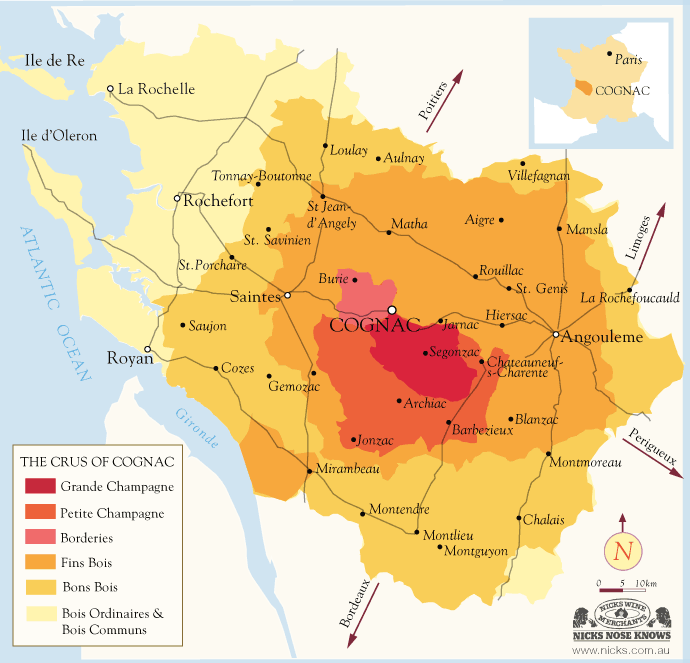
The six growth areas, or crus (singular='cru'), total about 80,000 ha of vines. The six crus are, in order of decreasing appreciation of the cognacs coming from them:
1. Grande Champagne
The core of Cognac, around Cognac and Segonzac, is the most prized, the Grande Champagne. (Note: the term 'Champagne' in relation to Cognac has nothing to do with sparkling wine, but means "open fields".) It has the greatest amount of Campanian chalk in its soil, and its vines yield the subtlest, most fragrant cognacs, and the ones that need the greatest maturation. The cru encompasses 27 communes, or winemaking communities, extending to a total of 35,700 ha. of which approximately 13,000 are planted to vine.
2. Petite Champagne
In a semi-circle to the south of Grande Champagne is the second key area, Petite Champagne, about twice the size but with around 16,000 hectares under vine. The soil here is still chalky, but it is a more compact and friable type known as Santonian chalk. This slight difference in soils means its cognacs are close in style to Grande Champagne, but without the finesse of the latter. If the two are blended, with at least half the cognac coming from Grande Champagne, the result is permitted to be called "Fine Champagne cognac".
3. Borderies
The third and smallest area is Borderies, a spur to the north of Grande Champagne, with 4000 hectares under vine. , With a microclimate unique in cognac, soils here are a mixture of chalk and clay with fruit ripenening earlier than the other regions. Its cognacs are full bodied but age quickly, and give backbone to a blend. Some table wine is produced here, because the clay results in wines with lower acidity.
4. Fins Bois
Surrounding all three of the above crus is the largest zone (354,200ha), Fins Bois, with around 33,000 hectares under vine. The soil here is chalk over a hard limestone base. Its cognacs also peak fairly quickly, around 10-12 years, and are used to soften the harder edge of the better cognacs when young.
5. Bon Bois
Again surrounding all four is an even bigger area, Bon Bois, where the soils are mostly composed of clay and are less suitable to the cognac vine. It has about 12,000 hectares planted. Its cognacs are quick to mature and can be somewhat coarse, so some houses refuse to inlcude them in blends.
6. Bois Ordinaires et Bois Communs (Bois a Terroir)
Finally along the coast is Bois Ordinaires, the site of Cognac's original vineyards, with free draining sandy soils and a maritime climate. Its 1,700 hectares of vines give an early cognac mainly for local drinking, usually described as posessing "a characteristic local flavour" - which is simply a euphemism for mediocrity.
Grape varieties & Viticulture
As in Armagnac, the main variety planted is the Ugni Blanc [right] (locally known as 'St Emilion' or 'Trebbiano' in Italy), which accounts for about 98% of Cognac plantings and 90% of the crop. Folle Blanche along with Colombard, are still authorised. Others that can be used in strictly limited amounts are Semillon, Sauvignon, Jurancon Blanc, Montils and Blanc Rame.
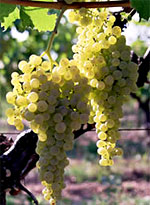
Ideally the grower is looking to pick his grapes when they are barely ripe. He or she is looking for acidity rather than alcohol, and would prefer 7%-9% Alc./Vol., though between 8%-8.5% Alc./Vol. is the norm. Chalky soils combined with high yields (102 hl/ha) and cool, wet weather giving slow ripening with low sugar accumulation facilitate such a high acid base wine. (This is also why cognac favours North-facing vineyards that delay ripening and why bad vintages for table wine-making - when the fruit does not fully ripen - are invariably good vintages for cognacs).
The grape harvest usuallns around the 3rd or 4th week in September. The majority of grapes are harvested mechanically, though some producers like Paul Giraud, Daniel Bouju, Remy Martin or Cartais-Lamaure still harvest at least part of their vineyards by hand.
The grapes are pressed without any delay, nowadays using horizontal flat presses or pneumatic presses. The juice runs into metal, stone or concrete vats for fermentation- no added yeast, sugar or SO2 (sulphur) is permitted (sulphur cannot be used because it creates off flavours in distillates by stressing the yeasts to produce aldehydes.) During fermentation a sludge-like substance called 'lees' (essentially made up of dead yeast cells) forms at the bottom of the fermentation vessel. This is a key ingredient for the production of the best cognacs, and is pumped over with the base wine for inclusion in the distillation. While the lees makes the wine more difficult to distil, it results in a more complex spirit with better depth and length of flavour. Fermention usually continues over a 2-3 week period resulting in a harsh, high acid wine unsuitable for table consumption but perfect for producing cognac: High acidity means the spirit will be able to pick up more from oak maturation while low alcohol delivers a better bouquet.
Distillation
Distillation begins immediately after fermentation is complete. The permitted still is the alambic charentais, basically a pot still though little changed from the last century except for the use of gas instead of wood to heat it. The copper is not merely a neutral vessel (the metal will not react with the wine), it also fixes fatty acids in the wine and removes sulfurous compounds from the vapours, so that (for example) glass stills do not give as good results.
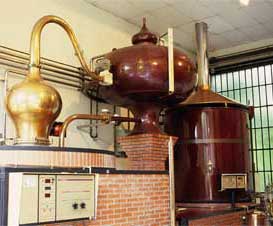
First the wine is warmed in a chouffe-vin (holding tank), then passes through to the onion-shaped choudiere (still) where it vaporises, and the vapours rise via the swan-necked chapiteou to the condenser, where a spiral serpentine tube passes through cold water and brings the vapours back to liquid form.
The still master lets the first of the spirit, the milky produit de tete, or 'heads' (about 1.2% of the distillate) run off until the spirit turns pure and clear. This is le cour or the heart of the distillation, almost colourless and without taste, which is retained, until the end when the spirit again turns impure, becoming the produit de queue or 'tails'. As well as increasing the number of desirable flavours, the tails can also increase impurities, so some skill is required to know when to cut them off. The first and last parts (heads & tails) will be redistilled, but the middle section, the brouillis, about sixty percent of the run, joins two other batches of brouilis for the second distillation. The process is repeated, and le cour becomes the infant cognac or the bonne chauffe. During both stages, the spirit is constantly tasted and the alcohol levels monitored so that the heads and tails can be seperated effectively. The whole distillation is performed over a 24 hour period so it is not unusual for the still master and his colleauges to sleep at the distillery.
Maturation
Cognac may not be sold to the public, or indeed called 'Cognac', until it has been aged for at least two years, counting from the end of the period of distillation (1st April following the year the grapes were harvested). It is not surprising then that cask manufacture has become a traditional business in the Cognac region , with about 500 coopers employed in the area to service the local industry alone. (Many of the larger cognac houses have there own cooperages). Baby cognac is filled into new, approximately 340 litre oak casks made from weathered Troncais oak (used for later-maturing Cognacs) or Limousin oak (having more tannins, suitable for earlier-maturing Cognacs) for up to six months. The cognac is periodically tasted and then moved to older, larger casks (approx. 500 litres) where by through contact with the oak and slow oxidation it gains colour and mellows over a period of anything up to a century.

These maturing barrels are stored in cellars known as 'chais' where an atmospheric balance between humidity and dryness controls evaporation rates from the casks. For example, drier conditions evaporate water and alcohol resulting in a cognac with greater delicacy, whereas more humid cellars evaporate only alcohol making for a rounder spirit. A black fungus, (Torula compniacensis Richon), thrives on the alcoholic vapours and can normally be seen growing on the walls, alongside cobwebs housing spiders which feed on bugs living on the outside of the casks. An altogether synergistic alliance that preserves the integrity of both wood and spirit. Most of the bigger Cognac houses have a small stock of very old cognac, stored in glass bonbons as they will no longer pick up anything from the oak, and in fact can fall 'sick' if left in cask for too long. Some of these venerable brandies go back to pre-phylloxera days, and demonstrate just how long cognac can survive.
Blending
Virtually all Cognacs are a blend of brandies from different vintages, and frequently, different growing zones. Even those from single vineyards or distilleries will be a mix of Brandies from different casks. As in Champagne, the production of local vineyards is sold to Cognac houses, each of which stores and ages Cognacs from different suppliers and then employs master blenders to draw from these disparate Brandies to create continuity in the house blends. Throughout this process, the focus is on aromatics, with the palate being secondary. The aim is to combine various aromas and flavours that work together without allowing one element to dominate. This is no easy task, especially given that it takes place over a long period of time, requiring accurate notes at each sampling. One Cognac enthusiast offered the experience observed that: "Given twelve different cognacs (a blender would have far more to consider) I was asked to blend a cognac to my taste. Half were rejected for various reasons, then came at least two hours of tinkering with the rest in varying proportions to get the aroma and taste I wanted. And that was to put together just one bottle!" Even experienced noses are challenged. Max Cointreau, one of Cognacs major players explains, "[The blender] has journeyed many, many years preparing the cognacs for bottling. It is a difficult job because you have to imagine how it will look, this eau-de-vie being blended with that eau-de-vie, for the 20 - 25 period it will be in cask." To give some perspective, a blend of V.S. Cognaccan be made up of 40 spirits from all six crus, while Hennessey's Paradis Extra and Remy Martin's Cordon Bleau are blends of up to 200 different cognacs. Still others are made up of thousands of component parts.
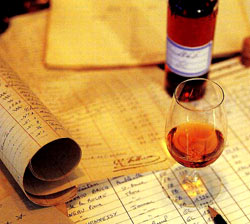
Before bottling, the Cognac is reduced to the legal maximum of 40% alc./vol. by adding distilled water (to young Cognac) or a mix of water and Cognac (to older Cognac). Only a very old brandy (over 40 years) has low enough alcohol not to require dilution before bottling. At this stage, sugar syrup (less than 8 g/l) can also be added. Yet another shortcut is caramel (burned sugar). Being dark in colour but slightly bitter in taste, it is not used to sweeten but to adjust its colour and establish consistency, or give the spirit the impression of being older and therefore 'smoother'.
Labels & Classifications
Because there are no age statements on Cognacs, the industry has adopted some generally accepted terms to differentiate Cognacs.
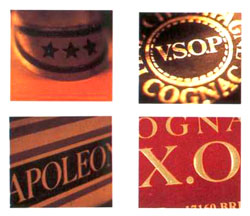
Generally, the question of what a cognac can call itself is based on the minimum age of the spirits in the blend. From the vintage to March 31 st of the following year, the new spirit is not rated. On April 1st it is rated zero, and twelve months later rated one, so is effectively about a year and a half old. This goes on until the spirit is rated five (six years later) when the series of controls are replaced by the honesty of the producer.
Cognac must be aged in oak casks for at least two years before being sold to the public. The label designations (VS, VSOP, XO) are based on the youngest eau-de-vie in the blend, but the contents are usually much older. But unlike some whisky producers, Cognac blenders are primarily concerned with balance, complexity and maintaining a house style, rather than age for age's sake. Thus, to call itself Three Star (VS or Very Special), a cognac must be made from spirits with a minimum of 2 years of age. VSOP (Very Superior Old Pale) contains cognacs whose youngest eau-de-vie is at least four years old. Finally, XO (Extra Old) cognacs are those whose youngest eau-de-vie is at least six years old. However any one of these may have much older material in them.
A cognac that comes exclusively from Grande or Petite Champagne may call itself that, or if the two are blended, Fine Champage.
Much less common are bottlings derived from a British habit of the last century, the shipping of young cognac in cask for maturation into importers warehouses. These early 'Landed' and 'Late Bottled' cognacs were peculiarly British, and could not be bottled as such elsewhere. Vintage dated cognacs were also quite common in the last century, but as most cognacs of modern times were blended, it was argued that a vintage date could not, or should not apply. So with the exception of the Early Landeds, vintage dating was outlawed in 1962. The rival Armagnac producers were delighted, as no such rule applied to them, and made much of their vintage armagnacs. Every French restaurant worth its salt sported magnums of armagnac with handwritten labels of various vintage dates. Presumably this domestic inroad into their trade upset the cognac houses, ever keen to preserve their lofty image. Consequently, an application was made to rescind the 1962 ruling, and Vintage Cognacs have just been re-introduced in France for the first time since 1946 under very limited conditions; for example, the casks must be topped up with brandy exclusively of the same age.
To confuse the matter further, the top cognac houses also produce certain super premium bottlings. These are labelled in the following way:
-
Extra by Camus, is their premium cognac beyond XO containing their oldest cognacs from the Borderies, Grande Champagne and Petite Champagne regions in a distinctive decanter style bottle.
-
Louis XIII by Rémy Martin, is composed of more than 1,200 of the finest eaux-de-vie aged between 40 years and a century in very old Limousin oak barrels.
-
Richard Hennessy by Hennessy, 'Richard' is a blend of over 100 eaux-de-vie aged up to 200 years. It is sold in a Baccarrat crystal blackman and is named after the founder of the company.
-
L'Esprit de Courvoisier is Courvoisier's leading cognac, presented in a hand-cut Lalique decanter, blended from eaux-de-vie up to 200 years old, and individually numbered.
-
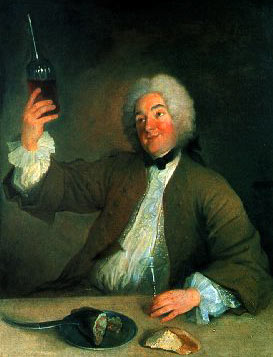 Moyet Antiques is Moyet's Très Vieille Fine Champagne and Très Vieille Grand Champagne cognacs blended from some barrels over 150 years old, individually numbered and signed by the cellar master.
Moyet Antiques is Moyet's Très Vieille Fine Champagne and Très Vieille Grand Champagne cognacs blended from some barrels over 150 years old, individually numbered and signed by the cellar master.
Indeed, what seems to change most frequently in Cognac are the labels, the shape of its bottles, and even the corks. This is almost always dictated by the demands of the market; Asian markets prefer sophisticated exuberance; European markets are more conservative, but are looking for a distinctive bottle, while Americans generally look for a brand name before packaging.
Enjoying Cognac
"Cognac has all the medicinal virtues of alcohol consumed in small quantities...It is therefore comparable to food, a food that brings you calories and strength." - Robert Delamain, Cognac producer.
Once uncorked, Cognac (like Armagnac) is stable enough that oxygen won't harm it, so you can leave it in the bottle or a decanter indefinitely. However, when storing Cognac, keep the bottle standing up, not lying on its side, since Armagnac can spoil if it comes in prolonged contact with cork. The traditional snifter is not necessarily the ideal choice of glass - arguably the best glass for Cognac has a rounded belly with a tapered chimney which helps to focus the aromatics. If you don't have glasses like this, a tulip-shaped champagne glass will suffice. Cognac's appearance can be evaluated according to its viscosity and clarity. When the glass is brought close to the nose, the most volatile scents are released: this is known as the 'montant'. Following a delicate rotating of the glass, the essential perfumes of the Cognac are distinguished. Aroma's found in Cognac generally fall under four categories, varying according to the age of the material:
|
FRUITY NOTES |
|
FLORAL NOTES |
|
Old eau-de-vie |
||
|
Passion Fruit |
 |
Vine flowers |
|
Muscat Grapes |
Orange flower |
|
|
Dried Fruits (fig), candied fruit |
Violet |
|
|
Jam |
Hyacinth |
|
|
Cherry |
Jamsmin |
|
|
Orange (peel) |
Honeysuckle |
|
|
Almond, walnut |
Lilac |
|
|
Hazelnut, peanut |
Rose |
|
|
Apricot, peach |
Dried flowers |
|
|
Pear, prune |
||
|
Young eau-de-vie |
||
|
WOODY NOTES |
|
SPICY NOTES |
|
Old eau-de-vie |
||
|
Vanilla |
 |
Nutmeg |
|
Oak |
Saffron |
|
|
Sandalwood |
Curry |
|
|
Cedar wood |
Cinnamon |
|
|
Cigar box |
Pepper |
|
|
Tobacco |
Capsicum |
|
|
Leather |
Clove |
|
|
Young eau-de-vie |
||
You may notice floral or fruited scents, such as dry limeblossom, vine flower, vine cana, pressed grapes, violet, vanilla...it's what is referred to as the second nose. The Cognac's aromas that participate in its bouquet combine with its flavour to provide an experience through both the taste and the retronasal channels. Only then can the personality traits of the spirit be revealed: roundness, smoothness, creaminess, refinement, lightness, rancio,  harmony... and so many other sensations that allow recognizing and appreciating each individual's preferred Cognac.
harmony... and so many other sensations that allow recognizing and appreciating each individual's preferred Cognac.
Cocktail: Between the Sheets
Shake with Ice, and then strain into a Cocktail Glass. Garnish with a Lemon Twist.
Cocktail: Summer Smash
Muddle lemon wedge with mint leaves. Shake with ice and strain to a highball glass filled with crushed ice. Float black raspberry liqueur. Garnish with mint leaves & raspberry.
Cognac Today
Cognac presently accounts for about two thirds of a month's worth of France's annual trade surplus (approximately 7.7 billion francs) with exports representing a staggering 91.8% of total production. 134.4 million bottles left Cognac's cellars in 1999. More than half of the cognac market is controlled by three major houses, Hennessy, Martell and Remy Martin. None of the major firms is vertically integrated, and there is a division between the producers and the growers. Although the growers are nominally independent, they are closely supervised. Some producers do own vineyards, but these are generally treated in a similar manner to other suppliers. The producers do not buy grapes; they buy wine and new brandy or young cognac (in some cases the purchases start only with young cognac).
As a luxury product, Cognac has always been susceptible to wide swings dependent on market conditions. Cognac sales have declined in the last 20 years, and between 1992 and 1997, total sales declined by one third. The oil crisis of the 1970's led to a world-wide decline, followed by the recession of the 1980's. Uprooting of vineyards occurred throughout this period. Some 10,000 ha have been pulled up in the past 5 years, mostly from the less prestigious areas. As a result of further declines in sales in 2001, some major houses have reduced purchases from growers, and some growers are converting to production of vin de pays table wines.
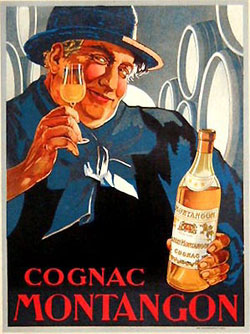
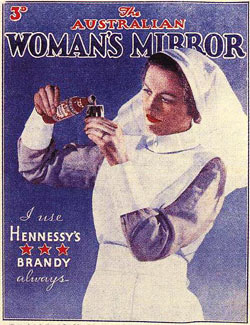
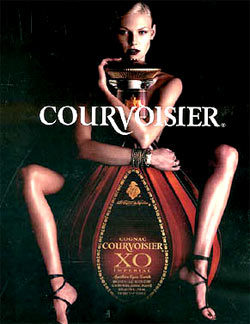
Above: Images of Cognac, old & new: For a long time cognac was presented as the drink for men of taste and society. But it wasn't long before producers realised there was something missing. Advertising for France's national spirit has since become even more daring than that of Champagne, as the 20th century promotion for Courvoisier Cognac on the right attests. In the centre is a rather curious Australian contribution, with a magazine cover promoting the use of Hennessy Cognac for, of all things, medicinal purposes!
The main market for Cognac in recent times has been the United States. Since the early 1990's, cognac has seen a significant transformation in its American consumer base, from a predominantly older, affluent white demographic to a younger, urban, and significantly African-American crowd. The spirit has become ingrained in hip-hop culture, celebrated in songs by artists ranging from Tupac Shakur to Busta Rhymes to Lil Jon, among many others. It is estimated that between 60 and 80% of the American cognac market is African American, the majority of whom have indicated in studies that the endorsement of popular musical artists is a factor in their preference for the drink, which also spawned its nickname 'Yak' (or 'Yack'). Many have credited hip-hop culture as the savior of cognac; after nearly floundering in 1998 due to economic crisis in Asia - cognac's #1 market at the time. The cognac industry has seen its annual sales climb to approximately $1 billion in America by 2003, a growth paralleled by hip-hop's rise into the mainstream of American music.
Cognac has capitalised on this trend by broadening the spirit's appeal across all age groups using the cocktail bandwagon. This push has been supported by a range of new Cognac based designer liqueurs such as Alize and Hpnotiq, so introducing younger markets to the spirit for the first time, albeit not in its traditional form. Regardless of the way it is consumed, Cognac remains a synonym of a product symbolising France and its art of living.
-
Recommended Reading: Cognac, A Liquid History. Salvatore Calabrese. Cassel & Co. United Kingdom, 2001.
 5/10 Cognac
5/10 Cognac